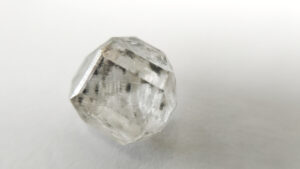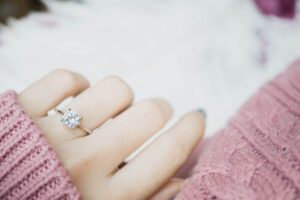
A lab-grown diamond is a diamond that is developed in a lab under a controlled environment. The chemical structure of a lab-grown diamond is the very same of a natural diamond. Even the optical and gemological properties are also identical. The creation of lab-grown diamonds doesn’t require environmental ramifications like a natural diamond. Chemical Vapour Deposition (CVD) method is popularly used to create lab-grown diamonds. Another method used is the High-Pressure High-Temperature (HPHT) method. Both involve the development of diamond from a diamond seed under the required environment with a carbon surplus. The time required for growing a lab-grown diamond ranges from a couple of weeks to a few months.
What Is Cubic Zirconia?
The crystalline form of Zirconium dioxide is known as Cubic Zirconia. Cubic Zirconias are colorless stones and look like diamond but is not real diamond. These stones are termed synthetic diamonds as they do not have the chemical structure of a real diamond.
Difference Between Cubic Zirconia Stones And Lab-Grown Diamonds

Cubic Zirconia requires less energy and labor to produce when compared to natural or lab-grown diamonds. Hence the cost of a Cubic Zirconia is far less than a real diamond.
The hardness of a lab-grown diamond is identical to a natural diamond. Hence durability of a lab-grown diamond is unquestioned. Cubic Zirconia stones are hard and they can withstand wear and tear caused by day-to-day life. But the hardness is less when compared with a real diamond. Mohs scale is a measure of hardness. A lab-grown diamond has a reading of 10 whereas cubic zirconia scores an 8.5 on the Mohs scale.
Lab-grown diamonds are diamonds grown in a controlled environment. Still, there are chances of tiny imperfections or inclusions. These inclusions cause cloudiness and can affect the clarity of the diamond. Cubic Zirconia stones are made using machines and there is less chance of imperfections and inclusions.
The density of a cubic zirconia stone is greater than that of a diamond. So for a real diamond and a cubic zirconia stone of the same carat weight, a real diamond is bigger.
Colorless diamonds are extremely rare and expensive. Even though the diamond is lab-grown, colorless diamonds are hard to obtain. Cubic zirconia stones are entirely colorless.
With a single glance, it is difficult to tell apart a lab-grown diamond and a cubic zirconia stone. But on closer inspection, it is possible to identify a cubic zirconia stone from a real diamond. This is possible because a real diamond reflects more white light whereas a cubic zirconia stone will give a rainbow-colored sparkle.
